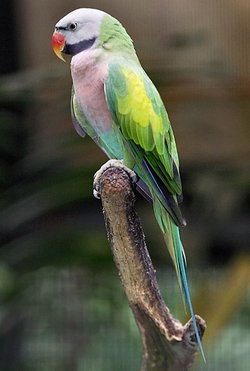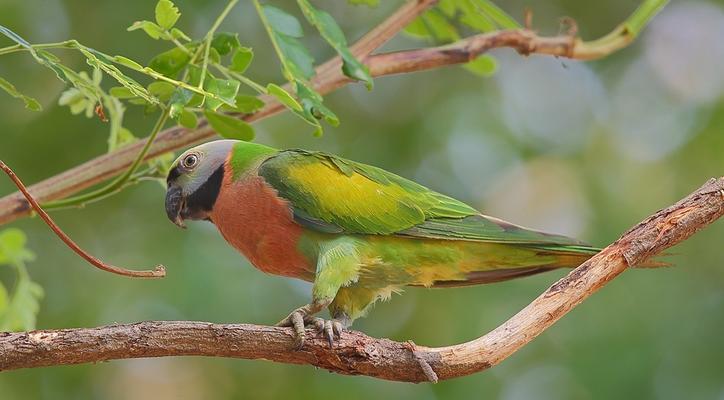Variety Overview
The Red-breasted Parakeet (Psittacula alexandri) is a popular choice among bird enthusiasts due to its exceptional ability to mimic human speech. However, training these birds to talk requires significant time and effort from their owners. Even with persistent training, some birds may not meet expectations unless specific issues are identified and addressed.
Beyond their vocal talents, these parakeets are also admired for their strikingly beautiful plumage. Their relatively low maintenance requirements make them a favorite among pet owners.
In China, these birds are affectionately known by nicknames such as “Yingge” and “Yingge,” particularly in the southwestern regions. Internationally, they are predominantly found in Asian countries like Thailand, Indonesia, India, Vietnam, Cambodia, and Myanmar.
Scientific Classification:
- Common Name: Red-breasted Parakeet
- Binomial Name: Psittacula alexandri
- Kingdom: Animalia
- Phylum: Chordata
- Class: Aves
- Order: Psittaciformes
- Family: Psittaculidae
- Genus: Psittacula
- Species: P. alexandri
Morphological Features and Identification
The Crimson Rosella (Platycercus elegans) is known for its stunning plumage, which is a major reason why they are so beloved by bird enthusiasts. Their vibrant feathers also help distinguish them from other bird species. Predominantly green in color, these birds appear mostly green when viewed from a distance. Besides the dominant green hue, their throat and chest feathers are either red or orange-red. Typically, males exhibit red throats and chests, while females tend to have orange-red coloring. Additionally, you can determine the gender of Crimson Rosellas by examining their beaks—females possess black-brown upper and lower beaks, whereas males have red upper beaks and brown lower beaks. However, this method is not effective for identifying the gender of young birds.
Crimson Rosellas are relatively large birds with body lengths exceeding 30 cm. Prospective owners should ensure they have a spacious birdcage ready.
Physical Characteristics of the Crimson Rosella
- Body Length: Approximately 30 cm; generally over 22 cm with a maximum length of up to 36 cm.
- Weight: Varies significantly among individuals.
- Beak: Males have red upper beaks and brown lower beaks; females have black-brown upper and lower beaks.
- Throat: Red in males; orange-red in females.
- Chest: Red in males; orange-red in females.
- Tail: Wedge-shaped.

Maintenance Tips
To successfully raise a rosy-faced lovebird , your first step should be selecting a healthy bird. Some young rosy-faced lovebirds available in the market are caught from the wild, which makes them less adaptable and more likely to die. Therefore, always inquire about their origin before purchasing. If you’re worried about raising a young bird, consider getting an adult one instead; adult birds adapt better and have lower mortality rates.
Once you’ve brought your rosy-faced lovebird home, a common concern is whether you can train it to talk. Here are some key points for teaching your bird to speak:
- Be patient; training won’t happen overnight. Without patience, your bird won’t learn to talk.
- Start with simple words before gradually moving on to more complex ones, similar to how humans learn languages.
- Ensure a quiet training environment; too much noise can distract your bird from learning.
- Use food as a positive reinforcement during training sessions. Experienced trainers suggest that early morning feeding times are ideal for this purpose.
Breeding rosy-faced lovebirds is another concern for many owners. Both experienced breeders and experts agree that it’s quite challenging. Successful breeding depends on various factors like proper cage conditions and a diet that includes all necessary nutrients. Thus, having some theoretical knowledge about breeding these birds is essential for any owner.

Feeding Techniques
For feeding Crimson-breasted Parakeets (also known as Crimson Rosellas), you can use a mix of rice, ramie seeds, and sunflower seeds (or peanuts) in a 7:2:1 ratio as their main diet. Supplement this with various fruits and vegetables. Additionally, provide fresh green branches, sand grains, and red clay regularly for them to pick at will. In winter, increase the proportion of high-fat feeds slightly; for instance, ramie seeds and sunflower seeds (or peanuts) can each make up 20% of their diet. During breeding periods, supplement their diet with cooked eggs. Cut fruits and vegetables into cubes or small pieces before feeding them. Disinfect with potassium permanganate solution and clean thoroughly before serving; remove any leftovers promptly.
For cage breeding, it’s best to spread fine sand on the bottom to facilitate parakeet movement on the ground and ease cleaning. Clean up leftover food daily and clean feces twice a week. Clean the nest box once in early spring and late autumn each year; replace the sand and disinfect the cage during these cleanings.
Taming Knowledge
When keeping parrots on a perch, it’s important to tether their feet with a light but sturdy chain and check it regularly. Red-breasted parrots may initially feel uncomfortable on the perch and need some time to get used to it. You can tame them within a few days by hand-feeding them their favorite treats like peanuts and fruits. To teach them how to “talk,” place them in a quiet room and start during their early morning feeding sessions. Say simple words repeatedly while feeding them until they learn each one. Gradually introduce new words from simple to more complex phrases, but avoid overly complicated ones. Having an adult parrot that can already talk makes the process much easier.
